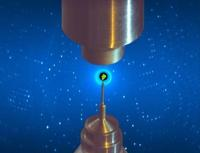Speaker
Description
Severe acute respiratory syndrome (SARS) is a viral infectious disease caused by the new coronavirus strain (CoV2). The SARS-CoV2 replication and transcription complex (RTC) is formed with at least 9 NSPs that are arranged into one functional assembly. The non-structural proteins (NSPs) Nsp7 and 8 are important components of this complex. Our overall aim was to investigate the structural basis of mechanism of binding and recognition of nucleic acids by Nsp7/8. First, we studied Nsp8 conformation alone and complexed with Nsp7 using small-angle neutron scattering (SANS). We produced a partially deuterated Nsp7/8 complex (dNsp7/Nsp8) and at the contrast match point of dNsp7 we singled out the scattering from bound Nsp8. The P(r) of dNsp7/8 has a bimodal shape indicating that the bound NSP8s are spatially separated in the complex. This shows that Nsp7 dramatically modifies Nsp8 conformation in the complex. Next, using the contrast match point of nucleic acids we single out the scattering of Nsp7/8 in complex with double stranded (ds) DNA and dsRNA substrates. The SANS profiles of Nsp7/8/DNA and Nsp7/8/RNA are best fit with a mixture of Nsp8/DNA (or RNA) and free Nsp7 dimers, supporting the dissociation of Nsp7/8 complex into smaller subunits. In contrast, Nsp8 alone did not bind the nucleic acids tested suggesting that Nsp7 is needed for Nsp8 to form a complex. Our results provide insight into SARS-CoV2 RTC that may be used to design novel therapeutic strategies for COVID-19.

